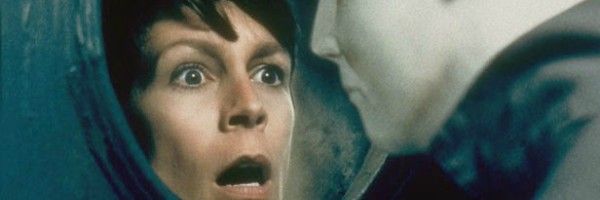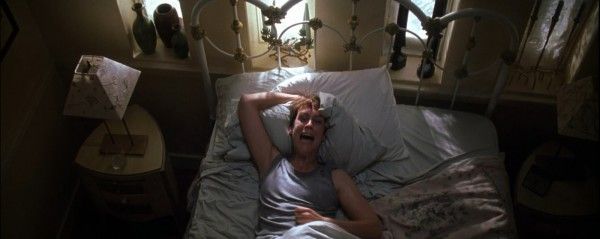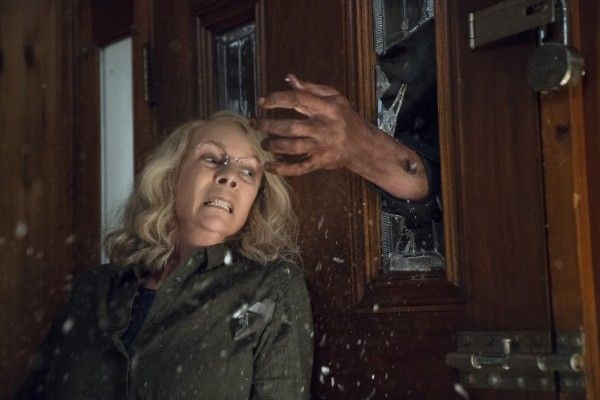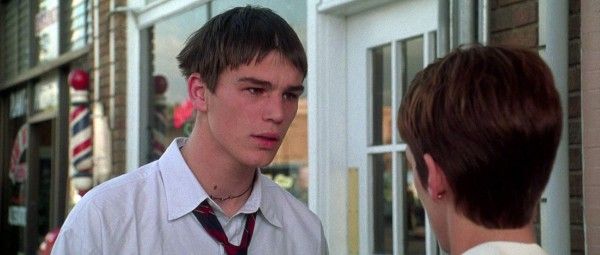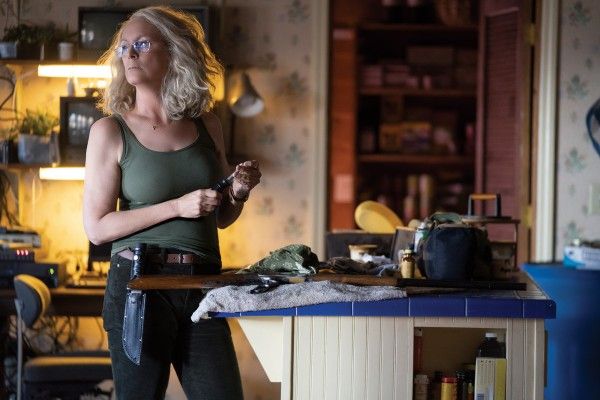On October 31st, 1978, Michael Myers killed several people in Haddonfield, Illinois. Laurie Strode survived, but not in any way unscathed. This weekend saw the nationwide release of Halloween, a new installment in the series that addresses the events of the first film. In it, Laurie is forty years older and itching for a reckoning with the man who stalked and terrorized her decades ago. The themes in this fresh sequel aren't entirely fresh, however. "Timeless" might be a better term. The new Halloween movie is a recalibration of the themes present in 1998's Halloween H20. In both films, Laurie Strode is a shell of her former self, grappling with PTSD and self-destructive behavior (in one, alcoholism, in the other, toxic paranoia) before ultimately facing down the source of her trauma once and for all.
When we meet Laurie Strode in H20, she is waking up from a nightmare, her latest in a long history of night terrors. Her son John (Josh Harnett) rushes in to reassure her that she's safe. Laurie now goes by the name Kari Tate, having faked her death in order to elude Michael for as long as possible. She now acts as headmistress of an illustrious academy, of which John is a rebellious student. After the nightmare, John goes into the medicine cabinet and picks a prescription bottle from the packed lineup of medications before bringing some pills to his mother, and she calms down. By evening, "Kari" relives memories of that fateful Halloween night in 1978, and by day she medicates with opiates and booze, eschewing any other therapeutic routes. Her boyfriend and colleague Will Brennan (Adam Arkin) is a counselor at the academy and offers to listen as she talks about her trauma, but she refuses while chugging a glass of wine.
In the audio commentary for the Scream Factory blu-ray release of Halloween H20, Jamie Lee Curtis provides some insight into the reasons for Kari's broken state: “The result of terror is dysfunction. And you need to see someone in the throes of dysfunction. The whole thing hinges on the fact that some part of her is dead. That it was killed by him-- and that she’s basically marking time the way damaged people do.” Even with a name change and a robust pill regimen, Kari still bears the scars from Laurie's terrifying experience. The Percodan and pinot grigio are nothing more than moist Band-Aids, barely covering the wounds.
Michael's presence is still looming over Kari, manifesting in a hallucination in which she sees him reflected in a window (behind which Will sits), and later as a shadowy figure which turns out to be the school guard Ronny (LL Cool J). An especially stretchy read might interpret those visions as a metaphor for Kari's trauma affecting her interactions with men, or not. But with every startling vision of Michael that turns out to be nothing, it becomes clear that pills and alcohol are not helping her or anyone around her. Her loved ones are affected, as it sometimes goes with unaddressed pain. Kari keeps a close watch over her son's movements and keeps him in a figurative bubble, which is practically a prison sentence for a teenage boy. In her mind, she is only trying to protect him from a very real threat, but it puts a strain on their relationship. John taps the nose directly with a half-joke, half-protest: “Today is the day you are going to realize that I am seventeen years old, and your over-protection and paranoia is inhibiting my growing process.” Of course it's understandable why she's a helicopter parent in this case, but it's also obvious that the over-protection is a negative ripple from the Haddonfield incident of 1978.
It's not until H20's finest scene comes along, with a swell of John Ottoman's recalibrated version of John Carpenter's classic Halloween theme, that Laurie Strode takes an axe up to the school where Michael lurks and takes control of her narrative. Kari has done what she could, but when the sun went down and Michael showed up, it was Laurie Strode who ultimately had to face him and her past trauma.
Fast forward to 2018 and the current entry in the series has emerged, one that dispenses with all but the events of the first two films. While Michael's motivations remained in the shadows in the new Halloween film, director David Gordon Green and co-writer Danny McBride dive headfirst into Laurie's mental and emotional state. At the age of 17, Laurie Strode engaged with evil incarnate and bears the scars on her psyche. Just like it is in H20, Laurie's trauma has manifested itself into near-debilitating behavior in the form of heavy drinking, and paranoia or hyper-vigilance, depending on who you ask. She has turned her home into a doomsday bunker, and spends her spare time keeping up on her weapons training, to the detriment of her relationship with her family. As with John of H20, Laurie's daughter Karen (Judy Greer, in a brutally underused performance) is affected by the ripple effect of that 1978 damage, with the surplus effect of inheriting Laurie's trauma. A painfully tense scene shows Laurie attempting to overcome her paranoid agoraphobia by leaving the house to attend a family dinner; she compensates for her anxiety by drinking heavily, humiliating her daughter and confusing her granddaughter Allyson (Andi Matichak). Add onto that Laurie's two failed marriages and the fact that she lost custody of Karen a few decades prior, it's clear that Laurie inadvertently infuses alienation into Karen's upbringing.
It's here that a marked difference occurs between the Laurie Strode of H20 and the Laurie Strode of this year's Halloween sequel. The Laurie of H20 bemoaned to her boyfriend that she was "hoping and praying that he would never find her," while the gun-toting grandma Strode of Halloween prays "every day that he would escape-- so that I can kill him." Forty years after that awful night, Laurie is ready to rumble, and ready to face her problems from the opening credits. Both films provide that confrontation, but it's fascinating to note the similarities in character focus leading up to the final showdown.
Halloween 2018 and H20 are wildly different movies-- in plot, in setting, in timeline, in quality. But they are kin. Both films address the unaddressed trauma, the hurt we carry that will circle back again and again like some invincible boogeyman-- unless we learn to process that hurt properly. Having a slasher deal with both inherited trauma and a Final Girl whose processing of that trauma is a major part of her arc is a relevant topic in our current socio-political landscape, and there's no better genre than horror to distill that into something digestible and impactful for the masses.

